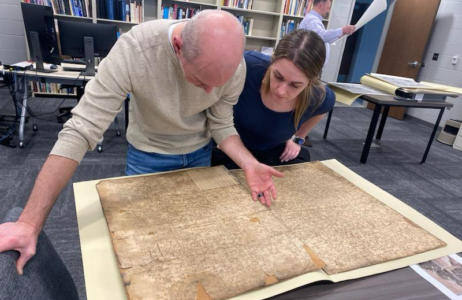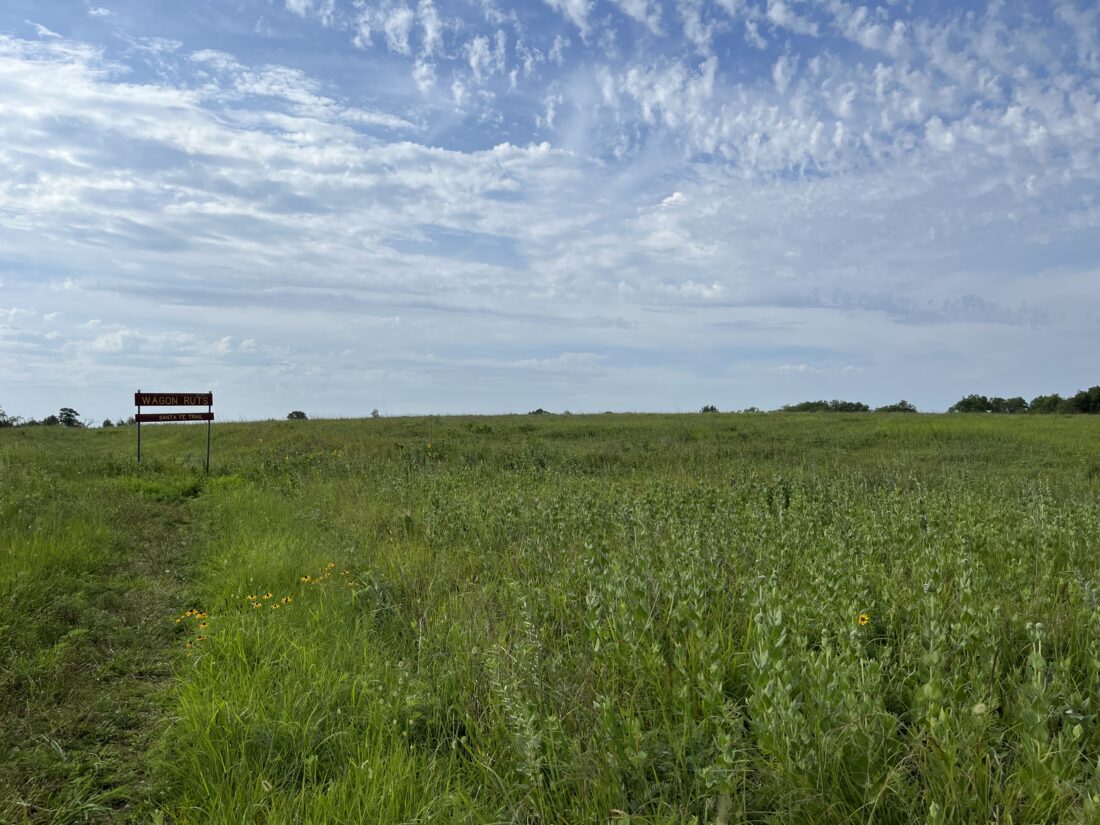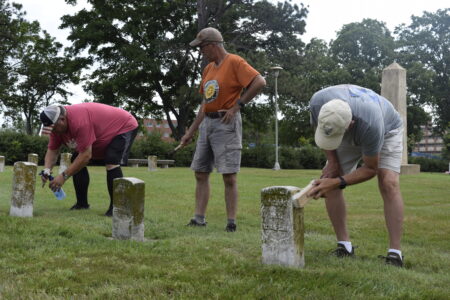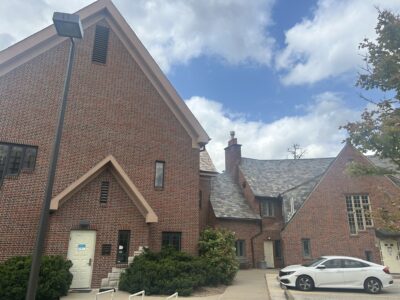Archaeologists to search Douglas County for artifacts; team is seeking landowners to participate

photo by: Augustana University
Austin Buhta from Augustana University points to an atlas.
If you have ever thought your piece of Douglas County property had an interesting historical story to tell, there’s now a team that may very well do some free poking around for you.
Professional archaeologists will be surveying fields, streambanks and other landscapes throughout the county as part of a nearly $100,000 project funded by the Douglas County Commission.
Archaeologists from the University of Kansas and Augustana University in Sioux Falls, South Dakota are now trying to determine exactly what parts of Douglas County to investigate. The team is especially interested in upland crop fields, properties situated along the Santa Fe or Oregon/California trails and areas with exposed streambanks.
Participation is free and voluntary, and archeologists will not remove items from the properties being surveyed.
The group will walk across the land and document any artifacts visible on the surface and the assessment will not involve digging. Findings will be documented through photographs, and maps and reports can be shared with property owners by request.
“Community involvement is vital,” team co-leader Austin Buhta of Augustana University said in a press release. “Whether you’ve found artifacts or have land with historic potential, we’d love to work with you.”
Residents interested in participating can email Buhta at dig@augie.edu or call (605) 274‐4369 for more information.

photo by: Douglas County
Ivan Boyd Prairie Preserve, located 3 miles east of Baldwin City on Hwy 56.
Property owners who participate in the program should get some satisfaction knowing that they are part of a pretty unique venture.
Kaitlyn Ammerlaan, coordinator of the Heritage Conservation Council, told the Journal-World that the county previously did a county-wide archaeological study – but it was in 1996, and there hasn’t been an update since.
“This survey is updating that record with a more up to date historical context and sort of revisiting some of the work that’s previously been done,” Ammerlaan said. “Typically, in the state of Kansas, archeology surveys are done like before construction or development occurs. This survey is not that. It’s more of a holistic perspective on the archeological history of the county.”
Ammerlaan said a study like this is not very common in the state because oftentimes, there isn’t a lot of funding to support projects like this.
The $99,677 in funding for the project was initially approved by the County Commission on Oct. 12, 2022, and it was kept in the Heritage Conservation Council’s reserve account until the assessment was ready to be conducted this year. The findings of the assessment will be presented to county commissioners along with the State Historic Preservation Office.
“The Heritage Conservation Council and our office has done a lot of work on historic resource surveys,” Ammerlaan said. “Every unincorporated township has been surveyed for the historic resources, which are structures and buildings that are at least 50 years old. And so this archeological survey is another layer to understanding our heritage.”
Buhta said in the memo to commissioners that between June 23 to June 26, team members from Augustana University conducted a preliminary trip to Douglas County to gather background information in preparation for upcoming fieldwork.
During the visit, the team also stopped at the Kansas State Historical Society in Topeka to collect GIS data related to previous archaeological sites and surveys conducted in the area. A comprehensive archive of earlier survey reports and site data was also downloaded from KSHS resources to support further background research.
The team also made connections with officials from KU and the Haskell Indian Nations University. Both universities may end up playing larger than expected roles in the project. Buhta said discussions are underway with KU to secure access toapproximately 750 acres of land for survey work. He did not specify where that land would be located. Other permissions, he said, are being sought for areas near Clinton Lake and the Lawrence Regional Airport.
As for Haskell, team members visited the Haskell Cultural Center and Museum in Lawrence where they met with Director Travis Campbell. Buhta said that Campbell expressed interest in collaborating on the creation of an ethnohistorical account of Haskell Indian Nations University for inclusion in the final project report. An ethnohistorical project could include the study of documents, oral histories, archaeological finds and other such resources.
The team also has secured the services of one local archaeologist who will provide some speciality services. Virginia Wulfkuhle has agreed to examine artifact collections believed to originate from the Wakarusa Valley and will provide information on the cultural and chronological characteristics of the assemblages, Buhta said in a memo to county commissioners.
In the memo, Buhta outlined five key tasks for the project’s success: reviewing Douglas County’s archaeological resources, evaluating and updating existing data, identifying areas for future study, raising community awareness, and informing elected officials to help support preservation efforts.
The project is expected to take several months. Farm fields are expected to be one of the key types of landscapes surveyed, and that means work on those fields won’t begin until after the fall harvest is completed. Survey work is also expected to take place in the spring and summer.
“Because we’re working with two universities, there’ll be students involved,” Ammerlaan said. “So the timeline is also kind of accounting for when students can be with the team too. It’s got lots of different moving pieces.”






